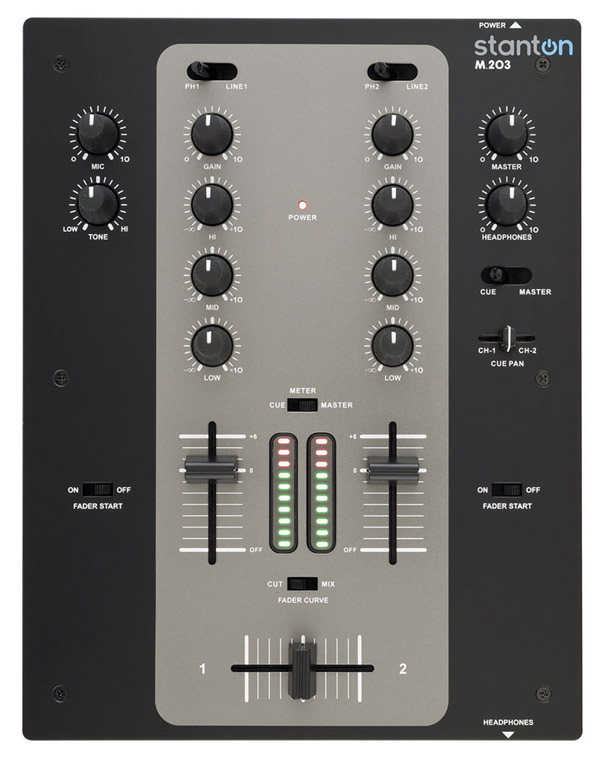 M.203 DJ Mixer – $99
M.203 DJ Mixer – $99
Pros: Sturdy construction, clean layout, replaceable crossfader, quality sound.
Cons: None.
Aspiring DJs – look no further. If you’re looking to get into the DJ game, the M.203 is the mixer for you. It offers everything you need to get started for mixing and scratching and beyond. Mixers that look, feel, and perform like this should be in the $150-$250 range.
The rugged steel design is solid and attractive. It mimics the M.207, which is Stanton’s next level up mixer. The unit boasts a simple, clean, and accessible layout. There are plenty of mixers at this price point that seem cramped with smaller interfaces, but the M.203 gives you plenty of room to move around. The faders operate smoothly and all of the rubber knobs have a desirable amount of resistance. The quality Alpha crossfader is replaceable, and allows you to select between cut and mix curves. This is essential for scratching. The M.203 gives you three EQs per channel: hi/mid/bass, which all have full kill capability. While blend mixing, this helps to get the creative juices flowing. There is also a meter switch for cue and master, which is a nice touch. On the back panel there are four inputs, two switchable phono/lines, and two lines plus one microphone input. Also on the back there are two outputs, a master and a record. The headphone input is located on the front panel.
After hooking up the turntables (including the great T.55 USB model provided by Stanton), mixing with the M.203 feels very natural and smooth. When scratching, the crossfader is very responsive. Blending is a breeze and everything sounds tight and clean. The mixer output is crisp and booming. Before you know it, hours will pass and you will wish you had recorded your set.
Features:
- Frequency Response: 20 Hz to 20 kHz +/- 2.0 dB
- S/N Ratio: Line (ref to Max. Level) Dynamic Range > 100 dB
- Noise Floor (Line in to any output): -86 dBV
- Max Output Level: (Unity Gain- Line Input): +14 dBV
- Crosstalk (Line to Line, Phono to Line, Line to Phono): < -90 dB at 1kHz
- Fader Kill: -85 dB
 SCS.4DJ Digital DJ Mixstation – $499
SCS.4DJ Digital DJ Mixstation – $499
Pros: Offers portability, solid construction, easy to use.
Cons: Slow load in at times, browser is also a bit slow – but an update to firmware V2.0 fixes most of this.
With the SCS.4DJ, simplicity is key. The SCS.4DJ is a self-contained, all in one, two channel digital DJ system. No external laptop needed here. The DJ software is integrated into the unit. This means all you need is music on a USB drive or even a smartphone, along with headphones and a sound system to plug into.
The layout will be familiar to anyone who has used CDJs or a digital DJ controller, and yet straightforward enough as to not intimidate beginners. On your left and right you have two decks with quality weighted jog wheels, pitch controls, a play/cue/sync/tap section, a loop section, and a thoughtful onboard effect section. The middle section houses a two-channel mixer with crossfader and a 3-band EQ with full kill capability. At the top middle section you find a crystal clear 4.3 inch LCD screen, a function jog wheel, and the software function buttons. The design is sleek and well thought out.
The device accepts most unprotected file formats including WAV, MP3, and AAC. About 300 tracks (about 2.5 gigs) were uploaded onto a USB thumbnail and plugged into one of four USB ports to start the process of track analysis. This took a very long time. An alternate and quicker option is to use Stanton’s QuickGrid software. Offered as a free download from the Stanton website, QuickGrid makes it possible for PCs and Macs to do the track analysis work offline at high speeds. The latest firmware for the SCS.4DJ also offers rapid association with QuickGrid’s database (2GB per minute), meaning databases made with QuickGrid can be used quickly with a one-time scanning process.
The SCS.4DJ software is incredibly easy to navigate with buttons for everything. The decks and mixer felt solid and comfortable. The music browser was a tad slow but made up for it with the “Sort” section that includes artist, genre, BPM, among others. An update to firmware V2.0 fixes most of this. The auto-DJ and BPM sync functions will be attractive for beginners. The sound was crisp and clean.
Overall, the SCS.4DJ is a solid piece for pros and beginners alike, especially at its price point. It does everything it promises to do. It just takes a little bit of time to get there.
Features:
- Fader Kill: -85 dB
- Mic Input: 1/4″ TRS
- Master Outputs: RCA unbalanced, 1/4″ pseudo balanced
- Headphone Output: 1/4″ & 1/8″
- Power: Supplied Adapter
- Power Into 33 Ohms: 180mW RMS @ 0dBFS
- Power Into 150 Ohms: 40mW RMS @ 0dBFS
- Minimum Safe Load: 16 Ohms
